 AD
AD
5 Of The All-Time Weirdest Gaming Gadgets
The games industry loves its kooky controllers, outlandish add-ons and unnecessary accessories doesn’t it? Hardware manufacturers are constantly whipping up all manner of ill thought-out peripherals, and while they don’t typically catch on (I mean, when was the last time you saw someone use an Xbox Kinect?), they serve as testaments to the sheer creativity of folks at hardware companies all over the world.
Technological oddities are entrenched in the DNA of interactive entertainment, even dating back to the days when “gaming” exclusively referred to gambling. For example, the late 1800s saw Charles August Fey inventing ‘The Liberty Bell’, the world’s first coin-operated slot machine —an innovation like no other at the time. Nowadays, slot machines aren’t exactly technological novelties: if anything they’ve been made obsolete by online alternatives from companies such as NetEnt, an online casino game provider which offers a casino welcome bonus for a variety of its games.
Let’s celebrate the weird side of the games industry by taking a look at five of the most baffling gaming gadgets ever released to the mainstream market.
The Power Glove

One of the most famous ill-fated gaming gadgets, the Power Glove was released in 1989 as a glove/controller hybrid for the Nintendo Entertainment System (NES). The device received a boom of promotion from its inclusion in The Wizard, the 1989 film that pretty much doubled as a feature-length Nintendo advertisement. Following that, the grey and black wearable controller became a retro 80s symbol, appearing in films that evoke the era like Ready Player One and Kung Fury.
Despite its immortalisation in pop-culture and strong marketing campaign, the Power Glove was just a little bit, well… useless. The vast majority of games didn’t really support it, and the ones that did hardly functioned anyway. In theory, the controller would have used a players’ hand movements to pull off moves in-game; in reality, it just saw players grasping fruitlessly at their TV screens like confused apes. A true commercial failure that only gains points from looking cool and being an early precursor to today’s — much better — VR controllers.
Game Boy Camera
The original Game Boy definitely had its flaws, things that people were happy to see addressed in following years —particularly when it came to the painfully dim black and green display. However, I can say with complete confidence that NOBODY looked at the original Game Boy and thought: “man, what this console really needs is a god-awful camera, then it’ll be perfect!” Alas, the fine men and women running Nintendo in 1998 felt it was necessary to release a camera add-on for the Game Boy with an accompanying (and equally dreadful) printer.
As anyone who’s seen a Game Boy display could predict, the photos looked terrible — like something from the first days of photography. The console wasn’t exactly sleek in the first place; it also didn’t help that the camera itself looked like an ugly parasite sticking out of the Game Boy’s cartridge slot. Another poor product from Nintendo. Perhaps it’s time to give them a break and move on to another company’s blundering attempt at innovation.
The SEGA Activator

If the Power Glove was overly ambitious, the SEGA Activator was absolutely insane. Instead of trying to translate hand gestures into in-game actions, SEGA’s 1993 gadget for the SEGA Mega Drive/Genesis claimed to translate the movements of a player’s entire body into moves for fighting games.
The Activator, essentially, was a plastic octagonal ring that was placed on the floor and stood inside. It made use of infrared sensors to detect a player’s movements and trigger a corresponding in-game action. Admittedly, it seemed to work better than the Power Glove — in that it worked at all — and was even repurposed with greater success in the 1994 Japanese arcade game Dragon Ball Z V.R. V.S.
Not an outright failure, but it certainly didn’t live up to the marketing hype of 100% accurate, immersive controls.
Atari Stick Station
This may be stretching the definition of the term ‘gadget’, but it more than makes up for it in the sheer weirdness department. The Atari Stick Station is a 1.5kg plank of wood. That’s it, just some wood with a gap that holds a single Atari 2600 controller. Apparently, some players complained that the controller would cause hand cramps after prolonged periods. This, for some reason, was devised as the solution.
Ignoring the fact that merely placing the controller on your lap would achieve the same effect, the Stick Station cost almost $15. That’s $15 in the late 70s/early 80s, so imagine a figure closer to $40-$45 for today’s currency. Imagine being a parent in the late 70s being pestered by your child to buy a $40+ plank of wood… you’d laugh them out of the room!
SEGA Dreamcast Fishing Controller

There are too many plastic peripherals out there for sports games (especially if you look at a certain Nintendo system that rhymes with ‘knee’). They’re all pretty bad, but at the very least they all function as shells for an existing controller — unnecessary, but not costly. The Dreamcast Fishing Controller, however, takes the cake for absurdity by virtue of it being a full, ¥5800 (£40-ish) controller, designed to look like a fishing rod, that was only designed for use with six games. Okay, eight games, but only if you count SoulCalibur and Virtua Tennis’ semi-official support.
With rudimentary motion support (to ‘hook’ the fish) and a fake reel (to pull ‘em in), the controller looked to have some fun quirks. With that said, NO amount of fun quirks could justify spending £40 on a fishing controller.







COMMENTS